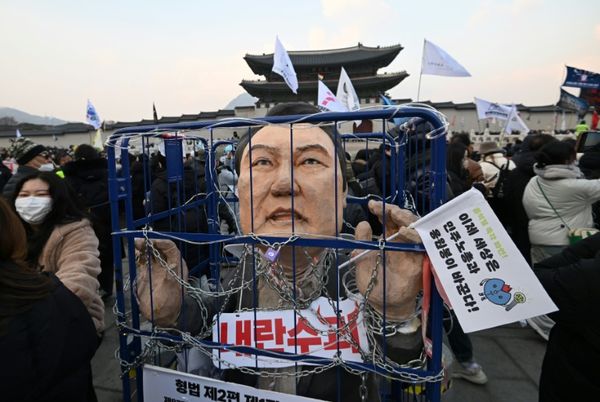
For five days, a mysterious unmanned Chinese spy balloon casually stalks the eastward skies of its deepest foe. Fighter jets rally, then stand down. A high-stakes diplomatic crisis ensues, frantic partisan politics come to fore, and an unlikely cover story rears its head. “Shoot down the balloon!” cries yesterday’s crazy man in all-caps. “We’ve got this,” smiles the US president, brandishing a thumbs-up. With that, the balloon’s explosive end over the Atlantic Ocean was nigh, courtesy of a single air-to-air missile.
With such facts at hand, who needs novels?
Nevertheless, international intrigue is yet to settle, with the true purpose of the 60-metre-tall balloon — espionage or weather monitoring — and its ensuing geopolitical consequences a source of continued tension between the two superpowers.
“What happened was extraordinary on a couple of levels,” John Blaxland, a professor in international security with the Australian National University Strategic and Defence Studies Centre, tells Crikey.
“Extraordinary politically, but also extraordinary in terms of the tactics and the approach taken. I don’t recall ever having heard of a shooting down of a balloon in the United States since World War II.”
Blaxland was referencing the thousands of Fu-Go “killer balloons” deployed by Japan in North America during the Pacific conflict, almost long since forgotten such was their general collective failure.
Some commentators have traced the use of military reconnaissance balloons to the French Revolution, while others have been quick to point out that the US famously authorised their use under the guise of “meteorological research” in the early days of the Cold War.
However, the earliest iteration of military balloons can be traced back beyond the 200 years spanning this period to one Zhuge Liang — a third-century Chinese war strategist who used paper lanterns to warn neighbouring villages of imminent attack.
Still, admirable historical symmetry notwithstanding, why would China resort to such a seemingly obsolete means of espionage when it operates one of the most advanced satellite programs globally, second only to that of the US?
It’s pure speculation, says Blaxland, but it’s possible the sheer quantity of space debris orbiting the lower-earth space environment provides a partial explanation.
“The space in which satellites have dominated for the past 50 or so years has become dangerously crowded and lethal,” he says. “So there’s certainly an appetite for the development of alternative systems [of spying].”
Modern spy balloons, Blaxland explains, were typically sophisticated, constructed by suspending “highly sensitive receivers” beneath the balloon that can take pictures, monitor radio frequency and provide useful radar intelligence. The controlled drift of the balloons also means the device can intercept a better array of real-time data than some satellite technology.
Indeed, it no doubt explains why China has in recent times developed a fleet of modern spy balloons, deploying them around the globe from India and South America to the US, the latter of which has reportedly tracked up to eight incidents of Chinese balloons in American airspace in recent times.
What makes the incursion of last week’s balloon so novel, says Blaxland, was its undisguised audacity — its visibility to the naked civilian eye and proximity to sensitive locations — something that may or may not feed the perception the balloon was, as China claims, an innocuous weather balloon haplessly blown into American skies.
The alternative theory, he says, was that it was, as the US suspects, always a spy balloon designed to test the resolve of Washington.
“It’s hard not to find credible the prospect of China exploring ways to really rankle the Americans and throw them off their game,” Blaxland says, citing the tensions bubbling over Taiwan and American sanctions on technology.
“The kind of intelligence this balloon would have gathered around detection capabilities and reaction is all very useful information to know if you’re planning to use balloons in the future with hostile intent, mindful of course you can use a balloon to drop a bomb.
“All of this information can now be fed into [China’s] next iteration of balloon plans.”
China, for its part, has declared its “strong discontent” at the downing of the balloon, which it characterised as an “overreaction”, citing its right to respond in kind.
Jingdong Yuan, an associate professor at the Australia-China Relations Institute, cautions against reading too much into that seeming threat, but nevertheless notes it will be difficult for Australia to extricate itself from any future conflict between the US and China as things stand.
Much of this, he says, owed to fundamentally opposed perceptions between the two superpowers as to what the regional order should and could look like, and Australia’s conscious decision to hinge its national security on its alliance with the US.
With prominent commentators such as Hugh White citing the high possibility of a serious great power conflict in the near future, Yuan says Australia should rethink its strategic relationships.
“The [US] alliance, AUKUS, and the Quad are all important for Australia,” he says, “but they are not ends in themselves but rather means to help it protect and promote its interests. I think the previous government got it wrong sometimes in letting the alliance determine or at least influence its interests.”
It is a sentiment shared, to some extent, by Blaxland, who points out that the entire US-Australia alliance is predicated on the deterrent power of the US.
When asked how valid that belief in deterrence was in China’s eyes, he says: “That’s something we’ll never know until it’s tested.”
There’s much to mull over, he says, as the country awaits the publication of the latest defence strategic review.







